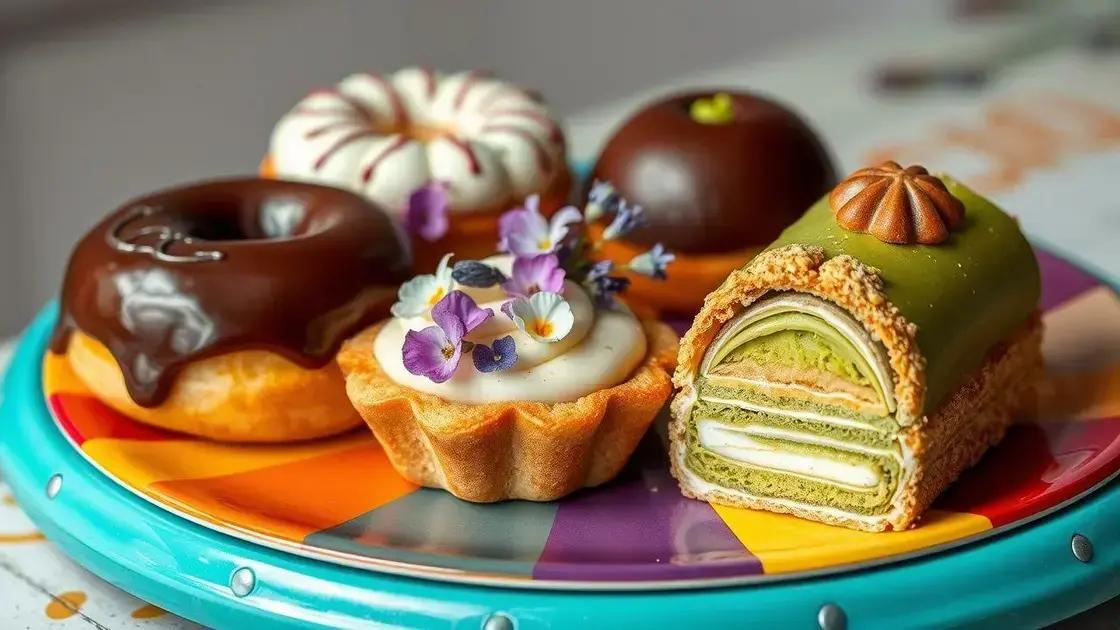Pastry chef blends cultures through innovative donut creations

Anúncios
Pastry chefs blend cultures through innovative donut creations by combining unique flavors and techniques, enhancing community engagement and celebrating diverse culinary traditions.
Pastry chef blends cultures through innovative donut creations that reflect diverse culinary traditions. Have you ever wondered how a simple donut can tell a story? In this article, we’ll dive into the delicious world of innovative pastry-making.
Anúncios
The art of donut making
Making donuts is more than just following a recipe; it’s an art form. From selecting the best ingredients to perfecting techniques, every step matters. The art of donut making intertwines tradition with creativity, resulting in delicious, unique treats that can captivate anyone.
Choosing the Right Ingredients
Quality ingredients are essential in donut making. Using fresh, high-quality components can enhance flavor and texture. Here are some key ingredients:
Anúncios
- Flour: Use all-purpose or bread flour for the right texture.
- Yeast: Fresh yeast can make donuts light and airy.
- Dairy: Milk and butter add richness to the dough.
- Flavors: Extracts and spices can elevate the taste.
After gathering your ingredients, the next step is combining them correctly. The dough should be mixed until smooth, ensuring the yeast is activated properly. Kneading the dough is crucial for developing the right elasticity.
Shaping Your Donuts
Shaping is where the magic truly happens. You can make classic rings, filled donuts, or even unique shapes. It’s all about creativity! Once shaped, the donuts need to rise. This step creates that fluffy texture we love.
While waiting, preheat the oil for frying. The right temperature is vital for achieving that perfect golden color. Too hot, and the outside burns; too cool, and they absorb too much oil. Finding that sweet spot takes practice.
After frying, let the donuts cool slightly before glazing or topping them. This part is also an art! You can make custom glazes and toppings. Sprinkles, chocolate, or even fruits can add a visual appeal that is hard to resist.
Creative Innovations
Today, innovative chefs are merging cultures through their donut creations. They’re not afraid to step outside the box, blending flavors from different cuisines. This fusion not only excites the palate but also tells a story of cultural diversity. Imagine a donut with matcha glaze or tiramisu filling; these combinations reflect a world of flavors.
In every bite, you taste the passion and creativity that went into the donut making process. It’s a delightful experience that goes beyond mere food; it’s an expression of art.
Cultural influences in pastry
Cultural influences play a significant role in shaping pastry traditions around the world. When we talk about the cultural influences in pastry, we see how different flavors and techniques come together to create something special. Each culture brings its unique story, celebrating local ingredients and culinary customs.
Global Pastry Traditions
Pastry chefs often draw inspiration from their heritage, blending techniques and recipes that represent various cultures. For instance, French pastries like croissants and éclairs showcase the skillful use of layers and delicate textures. In contrast, Scandinavian pastries often feature lighter, fruit-based fillings.
- Italian pastries like cannoli and tiramisu highlight a rich use of cream and cheese.
- Asian desserts, such as mochi and bao, focus on unique textures and fillings.
- Middle Eastern treats, like baklava, emphasize nuts and honey, creating a sweet and savory balance.
Understanding these differences helps us appreciate the depth of pastry as an art form. Chefs travel the world, gathering inspiration and techniques, which they then infuse into their creations.
Fusion Pastry Creations
The rise of fusion cuisine has allowed for even more creativity in pastry making. Chefs combine elements from different cultures to craft innovative pastries that surprise and delight. For example, a matcha macaron combines French techniques with Japanese flavors, creating a unique experience.
This blending of cultural elements doesn’t just make for delicious treats; it also fosters a greater understanding of global culinary practices. When a pastry incorporates both Italian and Japanese techniques, it tells the story of connection, showing how food can bridge cultural gaps.
Ultimately, exploring these cultural influences in pastry opens up a world of flavors and ideas. It invites pastry lovers to taste the globe, making every bite a delicious journey through tradition and innovation.
Unique flavor combinations

Exploring unique flavor combinations in pastry can lead to exciting culinary discoveries. Chefs are known for their creativity, pushing the boundaries of traditional desserts to create amazing treats that surprise your taste buds. By blending different ingredients, they craft pastries that offer new experiences.
Classic Meets Innovative
Many chefs use classic flavors as a base and then add a twist. For example, think of chocolate combined with spice! A chocolate donut with a hint of chili can provide a dazzling contrast between sweet and heat. This unexpected pairing can take your palate on a delightful journey.
- Lemon and lavender: This combination gives a refreshing taste with a floral note.
- Salted caramel and pretzel: The sweet and salty mix creates a deliciously crunchy effect.
- Matcha and white chocolate: This unique blend offers a creamy texture alongside a slight earthy flavor.
These creative combinations reflect a growing trend in the pastry world. Chefs are no longer sticking to classic flavors; they are experimenting and discovering exciting new pairings.
Texture Plays a Role
The texture of a pastry also enhances flavor experiences. For instance, pairing a soft cream filling with a crispy donut creates a satisfying contrast. Think of a choux pastry filled with rich chocolate mousse. The soft cake and airy filling meld beautifully, creating a delightful mouthfeel.
Innovative flavor combinations can also include fruits that are not usually associated with pastries. Adding exotic fruits like passion fruit or lychee can introduce beautiful acidity and sweetness, amplifying the overall flavor profile of a dessert.
Experimentation is key in developing these unique flavors. Chefs often share ideas and collaborate to find the perfect balance of sweet, savory, and tangy. The result is not just a pastry but an experience that tells a story through flavors.
The evolution of the donut
The evolution of the donut is a fascinating journey that reflects changes in culture, technology, and taste. From its humble beginnings, the donut has transformed into a beloved treat enjoyed around the world. Understanding this evolution helps us appreciate every bite we take.
Historical Origins
Donuts date back to the early 19th century. The earliest references show that Dutch settlers brought fried dough recipes to America. In fact, they made a treat called olykoeks, which translates to “oily cakes.” These early versions lacked the holes we find today.
- In the mid-1800s, the doughnut shape evolved with the introduction of the hole, which allowed it to cook evenly.
- The modern donut gained popularity during World War I when women served them to soldiers.
- Commercial production of donuts began in the 1920s with the invention of machinery that made the donut-making process easier.
As the years went by, donuts began to appear in bakeries all over the United States. They became an iconic treat, especially with the rise of coffee shops.
Modern Innovations
Today, the donut continues to evolve with exciting new flavors and styles. Food trends have pushed pastry chefs to experiment beyond traditional recipes. You can find donuts topped with everything from bacon to fancy glazes and unique fillings. In many pastry shops, creativity knows no bounds.
The rise of vegan and gluten-free options has also made donuts accessible to everyone. Now there are even artistically designed donuts that resemble works of art.
The continued evolution of the donut also involves adapting to health trends. Some shops now offer baked donuts instead of fried ones, making them a lighter choice. Despite these changes, the essence of the donut remains the same—a delightful treat that brings joy to those who eat it.
Community engagement through food
Community engagement through food is a powerful way to bring people together. Food fosters connections, offering a shared experience that unites diverse groups around a common passion. In today’s world, pastry chefs are leveraging this connection to build community and promote cultural exchange.
Building Relationships Through Shared Experiences
When communities come together for food-related events, it creates an atmosphere of camaraderie. Pastry competitions and festivals are great examples. They promote local talent while allowing people to sample different creations. These events encourage collaboration among bakers, fostering friendships and partnerships.
- Workshops can teach participants how to make traditional pastries.
- Community baking days bring people together to create and enjoy treats.
- Local markets showcase unique pastries, connecting bakers with their neighborhoods.
By engaging with the community, pastry chefs can create meaningful relationships. These connections extend beyond the kitchen, building a sense of belonging.
Cultural Celebrations and Awareness
Patisseries often use their art to represent cultural heritage. Events celebrating festivals from around the world allow local communities to learn about different traditions through food. Think of a Chinese Mid-Autumn Festival featuring mooncakes or a Dia de los Muertos event showcasing sugar skulls. These unique experiences provide insight into cultural practices while promoting inclusivity.
Food can also be a medium for raising awareness about important causes. Some pastry shops hold charity events where profits go to local organizations. This not only feeds the body but also nourishes the spirit of community involvement.
Ultimately, the bond formed through food brings people closer. Whether it’s through shared recipes, cultural experiences, or charitable contributions, food serves as a universal language that promotes understanding and engagement.
The journey of exploring pastries, from their cultural influences to unique flavor combinations, showcases the creativity and passion of pastry chefs. Community engagement through food emphasizes the power of coming together to share experiences and celebrate diversity. As we continue to experience the evolution of pastries, we also embrace the stories and connections they create. Ultimately, every bite of pastry not only delights our taste buds but also nourishes our sense of community and belonging.
FAQ – Frequently Asked Questions about Pastries and Community Engagement
What are some cultural influences on pastries?
Pastries reflect diverse cultures, with ingredients and recipes often rooted in tradition, such as French croissants or Middle Eastern baklava.
How can unique flavor combinations enhance pastries?
Unique flavor combinations, like chocolate chili or lemon lavender, surprise the palate and elevate the overall dessert experience.
Why is community engagement important in pastry making?
Community engagement fosters connections, allowing people to share experiences, learn from one another, and celebrate cultural diversity through food.
How have donuts evolved over time?
Donuts have evolved from simple fried cakes to a wide variety of flavors and styles, embracing innovation and cultural influences from around the world.






